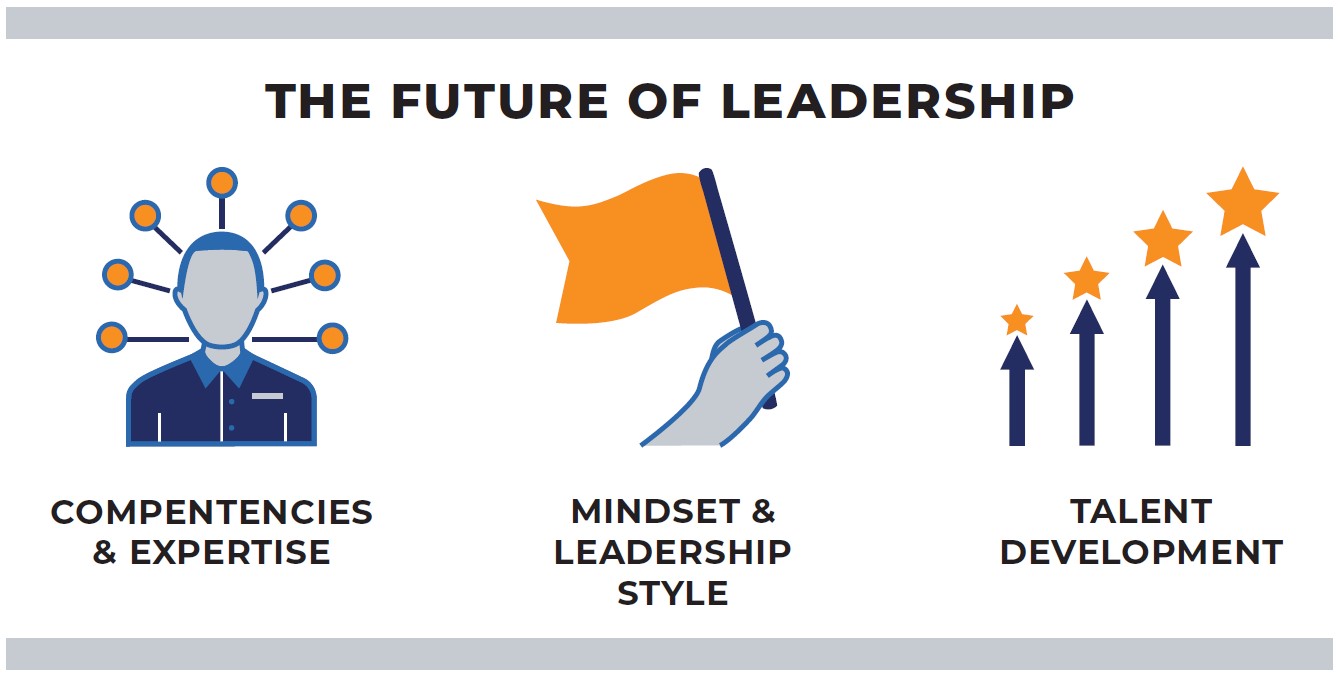Leadership in Healthcare: Keeping Pace With a Changing Industry
20 August 2020
As the healthcare sector shifts in response to market forces and changing expectations, leaders and administrative teams are constantly forced to find innovative solutions to new and unexpected problems. This paper summarizes insights from industry leaders around the world as to what those problems are, how they can be addressed through exceptional leadership, and how to stay ahead of challenges.
Major Industry Trends
1. Technology:
Changes in technological infrastructure/digitalization demand targeted investment and strategic re-training.
2. Workforce:
Issues of staff retention and specialization can best be addressed by identifying leaders capable of inspiring trust and creating meaningful workplace experiences.
3. Financial and Structural Concerns
such as aging populations and the increasing pressure to consolidate can only be addressed creatively and sometimes through radical institutional reconfiguration.
4. Changing Models of Care Provision
—including the rising importance of end-of-life care and emerging networks of alternative care providers—are changing the nature of the healthcare sector itself.
 Leaders were then asked what influences they look to as they seek to update best practices to account for shifting demands. Many pointed to personal experience abroad as essential background for upper-level executives, while others looked to new practices being developed by startups and incubators, or drew inspiration from other industries entirely.
Leaders were then asked what influences they look to as they seek to update best practices to account for shifting demands. Many pointed to personal experience abroad as essential background for upper-level executives, while others looked to new practices being developed by startups and incubators, or drew inspiration from other industries entirely.
Finally, respondents were asked to specify the traits, capabilities, and challenges that will define the next generation of highly effective leadership in healthcare. They pointed to hands-on talent preparation and mentorship as well as a robust set of hard and soft skills, with an emphasis on agility, flexibility of perspective, and brought experience with a variety of complex and cutting-edge healthcare models. Together, their answers reveal the critical importance of recruiting successfully at the leadership level for care providers like hospitals and other healthcare institutions.
Major Industry Trends
Technology
Among the most common concerns from survey respondents were those involving the integration of information technology (IT) infrastructure into both existing and evolving healthcare practices. The general mood was summarized by Philippe Leroy, CEO of the CHU Saint-Pierre in Brussels, who commented, “when it comes to questions of leveraging and managing data, one wonders whether the next locus of competition for hospitals and healthcare systems might not come from Google, Apple, Facebook, and Amazon, which have global data management capabilities and have launched bold and ambitious investment programs in healthcare.”
Julian Hadschieff, CEO of PremiQaMed Group at Medical Excellence Austria, agreed, citing data management as the single top concern for hospital executives in the immediate future. For Jeroen Muller, CEO of the Arkin Institute for Mental Health in Amsterdam, the issue is more specific. “Data is the new gold,” he said, and is the key to building competitive advantages through innovation. He pointed to transitioning ”from old closed IT-based infrastructure to open architecture” and “building new electronic patient records with much more emphasis on patient-centered platforms” as especially high priorities.
Another trend in data capture and management involves empowering patients. For Muller, new data systems will be critical to “shifting decision rights toward patients, enabling them to actively manage their own care,” while, at the same time, “scaling up e-health innovations to serve more patients.” Julian Hadschieff was in direct agreement about the critical importance of rapidly expanding e-health capabilities, as was Ale Houtsma, CEO of the Canisius Wilhelmina Hospital in Nijmegen. Philippe Leroy expanded on their views, writing, “data transparency at all levels is required to achieve a more fact-based approach to healthcare. Patients must be able to access their own electronic files, and care quality and outcomes data must be collected and shared more readily.” He described the required approach as “data-enabled managerial steering.”
A clear example of what might be required to keep pace with these trends was provided by Juha Tuominen, CEO of Helsinki University Hospital (HUS). He explained that “over the last five
years, HUS has increased its IT spending from 3.5% of its total annual investment up to 7.5%, in order to enhance the availability of data and knowledge management.” He noted that the change had been both facilitated and supported by a new law, passed by the Finnish Parliament in Spring 2019, which focused on increasing “access to personal social and health data for steering, supervision, research, analysis, and development in the health sector.”
Workforce
Healthcare executives noted two broad trends relating to workforce concerns. The first was summarized by Jeroen Muller, CEO of the Arkin Institute for Mental Health, who remarked, “in an increasing number of countries, we have seen problems retaining workforce.” He recommended addressing the issue by shifting compliance models away from those focused on oversight and towards those grounded in managerial trust. For Dr. Martin Rupprecht, Director of Personnel at Oberösterreichische Gesundheitsholding, the problem extends from retention into recruitment and development. From his perspective, and in the Austrian context, it is likely that in the near future “basic healthcare and nursing work will be done primarily by migrants, for which reason migration laws and policies are closely intertwined with healthcare issues.” Nicolas Van Oost, chairman, archipelago architects, reinforced these points and suggested that “a growing consideration of users’ well-being, whether they are treated or work there,” is the only way to effectively promote “the retention of qualified staff.”

The second major trend in this area involved the combination of automation, standardization, and specialization—in short, the narrowing and refining of staff roles and responsibilities. Dr. Rupprecht commented that one “negative trend” involved “doctors and healthcare staff trying to place clearer limitations on their own workplace responsibilities, both for legal reasons and to make sure that sufficient personnel are allocated to all critical components of each process.” Julian Hadschieff (CEO of PremiQaMed), noted that the tendency toward standardization was linked to automation and to the increasing use of data mentioned above.
Financial and Structural Concerns
Perhaps not surprisingly, nearly every respondent cited major financial and structural challenges as being among the top trends driving the industry forward. The most common concern, as highlighted by Juha Tuominen (CEO of Helsinki University Hospital) and by Ale Houtsma, (CEO of the Canisius Wilhelmina Ziekenhuis hospital), is an overall “explosion” in the cost of providing high-quality care. These dramatic increases are driven primarily by the aging population worldwide, combined with a range of other factors, prominent among them the need for the technological improvements mentioned above and the expense of personalized drugs.
A number of senior executives at the Furst Group, along with Dr. Rebecca Koch, Senior Director of Talent & Culture for Greater Asia at BD, pointed to an additional cluster of problems:
“difficulty securing reimbursements, restricted access to capital, intense cost pressure, and both hospital and market consolidation.”
An explication of the relationships among these issues was provided by Philippe Leroy, CEO of the CHU Saint-Pierre in Brussels. He commented, “economic growth is limited—on the order of 1% per year in most countries—while healthcare costs have consistently been growing by 3-4% per year, rendering them unaffordable over the long term. This is a major political issue and may lead to a change of paradigm in the way costs are reimbursed, shifting from volume-or act-based systems to systems that are results- or quality-based.”
Leroy joined Jeroen Muller (CEO, Arkin Institute for Mental Health) and Julian Hadschieff (CEO, PremiQaMed) in pointing to operational and technological innovation as the only means of successfully addressing these pressures. Said Hadschieff, “new and innovative services are pushing the market forward. The question is, how can we as medical care providers secure financing for implementing innovations of our own? And how can we derive sustainable business models from them?”
Crucially, the rising costs of care provision are the single greatest obstacle preventing hospitals from paying for innovation using standard funding sources. Mr. Leroy noted that “currently, more than half the hospitals in Belgium are loss-making” for this exact reason. The solution, all agreed, must come from changes in the way services are delivered. That brings us to our final major trend.
Changing Models of Care Provision
A majority of survey respondents indicated that emerging networks of medical care centers outside of major hospitals, together with the increasing number of joint ventures in care provision, provide both tremendous pressure to change the operational status quo and an opportunity to escape the trap of rising costs. As described by Dr. Martin Rupprecht, Director of Personnel at Oberösterreichische Gesundheitsholding, “the boundaries between hospitals and the ‘retail market’ are changing, with new group offices for doctors appearing and beginning to take over both pre- and post-surgery care, which was previously done by hospitals.”

Nicolas Van Oost, chairman of archipelago architects, summarized the nature of these changes. “Every possible answer to the major challenges the healthcare sector is facing have a single common element: a questioning of the established models and the usual frameworks used by hospitals.” For Dr. Rebecca Koch, Senior Director of Talent & Culture for Greater Asia at BD, that ‘questioning’ means looking to “deep collaboration across businesses and functions with both internal and external stakeholders.” For Ale Houtsma, CEO of the Canisius Wilhelmina Ziekenhuis hospital, it means “developing and implanting innovative care models, including telehealth,” and investing heavily in “networks and joint ventures.”
Here, too, respondents looked to innovation in evolving fields to help deliver answers. Julian Hadschieff, CEO of PremiQaMed, argued that “emerging and reinvented medical disciplines such as genetics and diagnostics are probably on the verge of changing the way doctors deliver their services.” And very similarly, also with increased emphasis placed on new technology, Juha Tuominen (CEO of Helsinki University Hospital) was unequivocal that hospitals must prioritize “innovative new care models and automatized treatment paths.” In addition, he noted, “the Covid-19 pandemic will speed up these development processes by a significant margin, likely as much as one to two years.”
Philippe Leroy, CEO of the CHU Saint-Pierre, was most explicit in linking these changes to models of care provision. He mentioned, “While there is a move toward ambulatory care and falling numbers of hospitalizations, those patients who are hospitalized are the ones suffering from the most serious conditions, and whose care is thus ever-more resource-intensive.” As a result, he said, executives “must reflect on the possibilities available for creating integrated end-of-life projects involving all stakeholders.” In particular, “moving to alternative care systems like ambulatory and home-based care is critical, as these systems ensure that the total cost exposure will be lower than if the patient were hospitalized.”
Models of Best Practices
As they seek competitive advantages and new means of balancing pressures applied from multiple angles, industry-leading executives model their best practices on a variety of sources. Most straightforwardly, several respondents agreed with Ale Houtsma, CEO of the Canisius Wilhelmina Ziekenhuis hospital, that their most consistent source of information and inspiration is the structured practice of “talking with colleagues and professionals.” Knowledge gathering may also include conversations with customers and business partners as well as discussions with peers and subordinates.
A second critical set of influences included looking to other industries, with specific emphasis placed on “technology adoption and adaptation” sectors such as “retail, entertainment, and hospitality,“ according to the Furst Group. Dr. Martin Rupprecht, Director of Personnel at Oberösterreichische Gesundheitsholding, added, “I am in various networks in healthcare and find much of my inspiration there, through interaction with local and international colleagues.” The focus of these efforts is “to bring value from one system to another,” in the words of Jeroen Muller, CEO of the Arkin Institute for Mental Health. “Learning from other cultures and systems means shifting your role as CEO and stretching your mindset and capabilities,” he said.
Along with a focus on other industries, several respondents noted the value of focusing on “innovation hubs, startups, and incubator and accelerator platforms,” along with trade events such as “industry meetings, industry screenings, trade fairs, and specialized or targeted travel to other countries” (Julian Hadschieff, CEO, PremiQaMed). That final list item is key. Almost every executive mentioned that international experience was an important element of developing their own expertise and perspectives. Ale Houtsma, for instance, pointed to two years spent in Stockholm as a critical counterpoint to more than two decades spent working in Dutch hospitals. For Jeroen Muller, “there are many things we can learn from each other by comparing systems across national borders. For example, [Dutch hospitals] can learn from England’s NHS, and the way they collectively benchmark costs and implement best practices swiftly thanks to a relatively centralized manner of working. At the same time, however, they over-emphasize costs and might themselves learn valuable lessons from more value-based approaches used in other countries.”
The Furst Group, Dr. Rupprecht, Dr. Koch, and others pointed in particular to single-payer healthcare systems in Northern Europe, Scandinavia, and Canada as sources of inspiration.
The Future of Leadership
Industry executives weighed in on a number of questions related to effective leadership, talent management, and changes that they perceive in the demands placed on healthcare leaders. They also offered their thoughts on how those demands can be ameliorated, satisfied, or both. The answers they gave can be broken down by focus: one group of insights relates to “hard skills,” and to issues of competence, work experience, and expertise. The other focuses on “soft skills,” with greater emphasis on mindset, vision, and leadership style.
Competencies and Expertise
The first form of expertise highlighted by interviewees was the ability to respond flexibly and adaptably to emerging problems. Dr. Rebecca Koch, Senior Director of Talent & Culture for Greater Asia at BD, said that the leaders of the future will need to display a “more agile leadership style, characterized by greater collaboration and transparency.” She highlighted five kinds of agility: “people, change, mindset, results, and learning.” Julian Hadschieff, CEO of PremiQaMed, agreed, writing that, “as the continual acceleration of change seems to be the only constant, tremendous agility in leadership will be required,” and specifically noted that executives must be able to “handle both the rate of change and the speed of change.”
A second trend related to familiarity with other industries, and the benefits of possessing both industry experience and medical expertise. Juha Tuominen, CEO of Helsinki University Hospital, said he “believes that the combination of substance understanding and visionary leadership skills will be increasingly needed in the future. While there are some areas where business experience alone will suffice, more often earlier industry experience is best accompanied by relevant technical understanding.”

Other leaders expressed the same sentiment. For instance, Philippe Leroy, Director General of the CHU Saint-Pierre, asserted that “talent must be attracted from other sectors and industries,” although he noted that doing so can be difficult given “the limited attractiveness of the healthcare sector for reasons including salary packages.” Julian Hadschieff said that leaders must be able to “handle the multifaceted complexity of the healthcare business,” while Ale Houtsma, CEO of the Canisius Wilhelmina Ziekenhuis hospital, suggested that they would need to “be driven by content, not by finance.” The Furst Group had the same view, responding that new hires would need to “adopt a more macro perspective—broader markets, other countries—and be students of other industries’ transformations around the adoption of technology, modifications to customer service models, and responses to changing consumer expectations.”
The third major trend was summarized by Dr. Martin Rupprecht, Director of Personnel at Oberösterreichische Gesundheitsholding. He noted that modern hospital systems increasingly rely on independent, self-organized teams, and that, “new leaders must be prepared to work with these novel organizational structures…The question is how many leaders you need to have for a given unit to function, and where self-organizing will suffice, allowing leaders to concentrate on developing and refining concepts and structures.” Julian Hadschieff agreed, saying, “not everything can be done by the company or manager themselves. The leaders of the future will need to be focused on collaboration.” For Jeroen Muller, future leaders “will need to exercise political power with an understanding of the viewpoints and emotions of those around them, and they will need to be able to distribute their leadership to others.”
The Furst Group stood out for their focus on the fourth competence-related trend, which involves the ability to prioritize and effectively make change in relation to cost pressures and the need for technological innovation. “For the foreseeable future,” they noted, “leaders need to focus on rising costs and reduced reimbursements, as well as adopting new technologies to address patient access to information and interaction with their care teams.” They highlighted experience with “cost-reduction initiatives and elimination of redundancy” as strong qualifications. Julian Hadschieff emphasized the ability to integrate. Future leaders, he said, must be able to “merge technology, innovation, and legacy business optimization practices at the same time,” because “the mutual importance of the digital and analog components of the sector have to be understood and managed.”
Mindset and Leadership Style
Among those respondents emphasizing soft skills was Philippe Leroy, who said, “there is a clear need for change agents and for project management capabilities. There must be a shift in mindset to a much more entrepreneurial one, even in the public sector.” Ale Houtsma emphasized the ability to develop “a strong vision”.
That capacity for vision, however, must be balanced with a particular leadership style. For Ale Houtsma, this leadership style can be described as “modest”. Leaders, he explained, must display “the ability to create strong networks, and a modest but strong approach to leadership based on challenges, support, trust, and discipline.” Julian Hadschieff added that, “the new challenge is to inspire quite different generations in a workforce from baby boomers to generation Z.” Rebecca Koch called it “servant leadership.”

But this point was represented in greatest depth by Jeroen Muller, CEO of the Arkin Institute for Mental Health, who expounded the critical details. “It is my sense we need thought leaders more than we need financial expertise. We need leaders who create meaning, and who evoke trust and inspiration in the workforce, who are strong on values and process. These individuals lead by example, both within and outside the organization. These attributes are critical because the needs and intentions of the new generation of the healthcare workforce is changing. They no longer want to work for organizations that simply provide money for work. They want money, but they also want improved work/life balance and to work for organizations that possess a clear purpose.”
Talent Development
Many respondents also had concrete advice for senior executives looking to assist in the training and development of more junior colleagues. Philippe Leroy described critical timeline constraints: “at the CHU Saint-Pierre, these topics are addressed by the top management with a 10-year plan, which is used to structure a 3-year plan, which in turn defines the 15 concrete priorities to be managed by multi-disciplinary teams.” According to Dr. Martin Rupprecht, the best strategy for implementing those concrete priorities is often to engage in staff exchanges and cross-training with other local medical institutions, allowing for the spread of new ideas.
Julian Hadschieff expressed a similar view, writing that, “the expansion of our company has given us valuable opportunities to grow, and to develop the talents of our future leaders using a combined program of job enrichment, job enlargement, job rotation, and assignment to a wide range of projects.” Similarly, Juha Tuominen said that job rotation is critical for new leaders to develop the necessary broad perspective.
Others recommend close personal mentorship, with Jeroen Muller saying that his team prioritizes “personal attention to the individual development of our talents, including talent scouting and coaching.” Ale Houtsma said he relies on the same processes, with the goal of “helping to develop a vision-based and deeply insightful understanding of different healthcare models.” Emphasis, he said, should be placed on “helping to develop not only management skills, but also, and most importantly, leadership skills.”
Conclusions
If there is any single message to be drawn from the advice provided by these industry leaders, it is that their counterparts over the coming decades will face a bewilderingly complex and contradictory array of social and operational challenges. Rising cost pressures, the tendency toward consolidation, and the need to fundamentally reconsider models of care provision must be confronted alongside radically altered demands from hospital staff and from patients.
The executives who responded to our survey provided just one overriding message about this tangle of concerns: that solutions will need to be not only innovative, but multi-directional. New pricing structures, for instance, will need to simultaneously address both exploding costs and workforce retention.
The leaders capable of rising to these challenges will be extraordinary individuals. They will possess a broad array of experiences, deep familiarity with multiple competing models of success in the healthcare industry, and a clear understanding of how to inspire trust both in themselves and their visions of the way forward.




